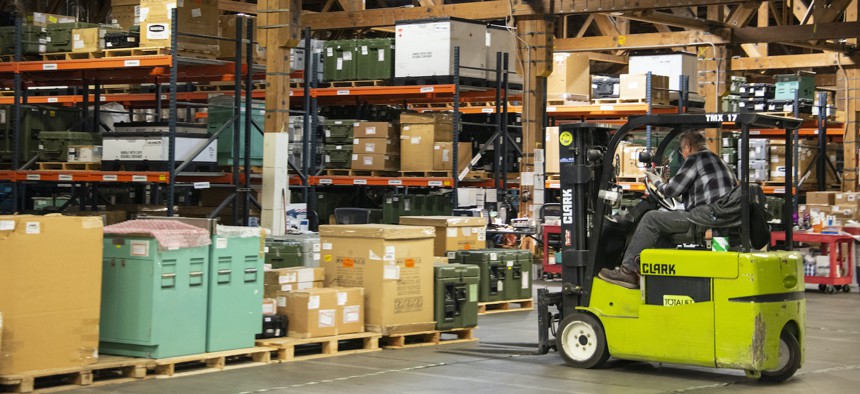
An employee moves medical equipment in a warehouse at a U.S. Army Medical Materiel Agency site at Sierra Army Depot, California. U.S. Army / Katie Ellis-Warfield
The Army doesn’t know where a lot of its excess arms and gear are
As allies' needs soar, officials are racing to get a clearer picture of what's available.
The U.S. Army has warehouses packed with weapons its soldiers no longer need. But the service doesn't know where they all are, nor what condition they’re in.
Now, amid increased demand from U.S. allies and partners, Army leaders are pushing for an updated database of those stored weapons.
“Sometimes we don't really know where all of our excess equipment is,” Army Undersecretary Gabe Camarillo said Tuesday at the Association of the U.S. Army annual conference in Washington. “We have a lot of it, and it's accumulated over time.”
Not all of it is needed, and the service is working to rid itself of superfluous weapons and other equipment, Army Chief of Staff Gen. Randy George said.
“We are getting rid of excess equipment starting now,” George said during a luncheon address.
The U.S. military was already working hard to send excess defense articles to allies that need them. The Pentagon has been fast-tracking weapons to Ukraine since Russia invaded in February 2022, although the future of such aid is in limbo after the House ousted former Speaker Kevin McCarthy, R-Calif. Then on Saturday, Israel was attacked by Hamas, and United States—a major supplier of weapons to Israel—has vowed to accelerate that assistance. Meanwhile, there’s been a push for the U.S. to arm Taiwan to deter invasion by China.
“This excess equipment may be offered at reduced or no cost to eligible foreign recipients on an ‘as is, where is’ basis in support of U.S. national security and foreign policy objectives,” according to a U.S. State Department fact sheet.
But the Army needs better, digital information about what it has in those excess stockpiles, Camarillo said.
“I'm working really hard with Army Materiel Command to find ways to more rapidly and in the digital fashion to catalog what we currently have, not relying on the clipboard and supply soldier who's sitting there taking notes and putting it on a piece of paper,” he said.
Unlike the Navy and Air Force, whose excess ships and planes are enormous and stored in a select number of locations, the Army’s smaller weapons puts it in a unique situation.
“I think the difficulty perhaps for the Army in particular is that there are so many different types of items in their inventory,” said James Hursch, director of the Defense Security Cooperation Agency, the arm of the Pentagon that oversees foreign arms sales. “That makes it really hard to know and keep track of each of those things.”
In the early 1990s, Hursch worked in the excess defense articles program for DSCA’s predecessor, the Defense Security Assistance Agency.
“I spent a lot of time back there in the 90s talking to sergeants at [Defense Reutilization Marketing Office] yards about what they had in their stocks and what I could pair with the requirements we were seeing from foreign military sales customers,” Hursch said.
At the time, not long after the end of the Cold War, the U.S. military was moving excess weapons from Europe back to the United States.
“The other important thing isn't just to know what you have [in excess stocks], it's what is the condition of what you have?” Hursch said. “It's really important for partners and allies to go and look at the equipment before they accept it.”
Most equipment is given “as is,” meaning it might not be in working condition.
“It really does involve, even if you have a pretty good idea of what the inventory is, people going out and actually [being] on the ground, looking to make sure that truck has an engine under the hood,” Hursch said.




